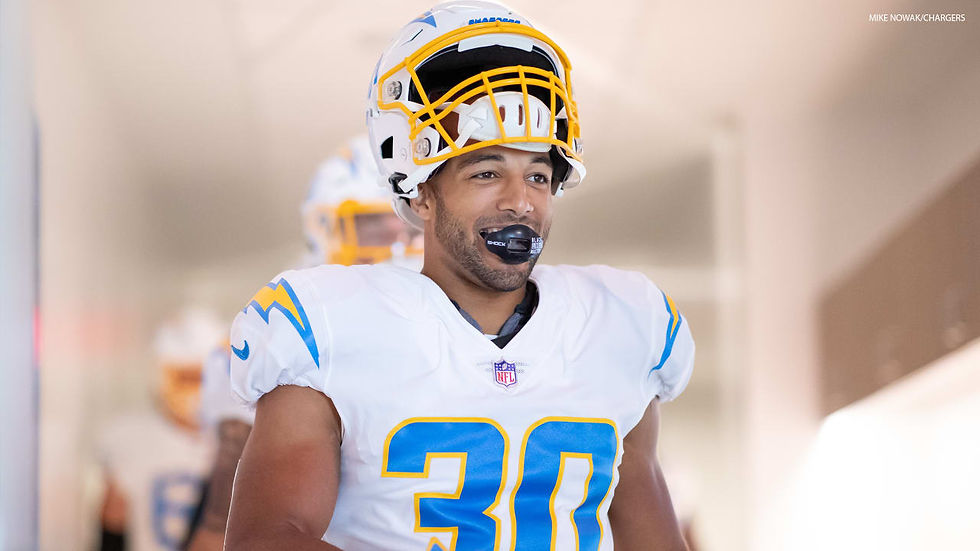2020 Rankings
- A-Z FFB

- Jul 30, 2020
- 7 min read
Updated: Dec 3, 2020
Hello, friends! First off, thank you for checking out this article, I am nervous (but excited ) to share this with you.Chances are if you follow us (or any other fantasy football content creator) you are going to be most interested in our player rankings, so here are mine!
Disclaimer: when comparing my total points to other analysts in the industry, it made me realize that I might have been a little generous with how many points (specifically TD's) I had a player scoring, BUT when I step back and look at the list of names, I really do like the order in which these names fell. (Hell yeah, a Bill Nye GIF!!!)
This year I tried something brand new (to me). I build projections! In past years I would just look at the previous year's finish and guess who would get better, who would get worse and who would stay about the same. Thankfully I am intuitive enough that I was right more often than I was wrong, but boy oh boy did I have some major misses... This year I decided to try out building rankings via projections, and let me tell you, I am a believer.
Player/team projections are not new to most fantasy analysts, but they were new to me, and they might be new to you too. If you are not familiar, projections allow you to go team by team, player by player and project what you expect from the team/players ahead of the upcoming season.
Projections are highly driven by research and data analysis. For example, I cannot just look at Kyler Murray and guess that he is going to throw the ball 700 times for 6,578 yards and 58 TD's. When building out projections there are a multitude of variables that need to be considered including (but not limited to):
Prior year(s) performance: Looking at the past seasons a player has posted in the NFL is one of the easiest, and most beneficial places to start. Looking at previous seasons can help you realistically gauge what you can expect from a player in a future season. Obviously none of us are psychic, so projections can basically be boiled down to highly educated guesses based on statistics.
Coaching Changes: Coaching changes are often overlooked by casual football fans, but head coaches and coordinators are the heartbeat of NFL teams. The coaching staff ultimately dictates offensive (and defensive) scheme and philosophy. If a new head coach or OC is hired, be sure to look at where that individual coached last, and which players on those teams stood out. This can steer you towards OR away from certain players based on how you think coaching changes will impact a player's outlook. Example: The Cleveland Browns hired HC Kevin Stefanski this off-season. When you think Browns, you think Baker, Odell and Jarvis... but Kevin Stefankski just came from Minnesota, where Dalvin Cook had an ELECTRIC season.. This should tell you that Nick Chubb (and Kareem Hunt) may emerge as the focal points of the Browns offense, so don't overdraft OBJ in the 2nd round.
Team Changes: If a player changes teams in the off-season either via trade or free agency, you have to factor in how you think that team wants to use the newly acquired player. There are some tell tale hints that can give you some insight:
Trade Value: What did the team give up in order to gain that player?
Contract: How much money did they give to a free agent player in order to gain that player?
How does the newly acquired player fit into the offensive (or defensive) scheme?
What does this tell you about the direction that the team is going?
Injuries: Injuries are tricky. It is hard to build out full season projections for a player if they missed a significant portion of the previous season. You can always look at a '16 game pace' and do some quick math to see what that player would have done if they didn't get injured... but even then it is hard to count on a player maintaining that same exact pace over an entire season... There are a multitude of variables that we can't really ignore with injuries, but there are still plenty of metrics that can help you better understand how the team was intending on using a certain player before an injury occurred. Check out metrics like these:
Attempts per game (QB): Does this team throw the ball a lot?
Rushing attempts per game (RB): Does this team try and establish the run?
Targets per game: Are the WR's heavily targeted?
Snap %: Is this player ON THE FIELD? That is important....
ADOT (average depth of target) [WR]: Is this player a deep threat? Or do they do their work in the short and intermediate areas of the field?
etc.
NFL Draft: This one is tough. It is hard to project how a rookie who has never played a NFL snap will perform at this next level. Draft capital (draft position) is an important factor that you can consider. A 1st round selection is going to have more opportunity than a 4th round selection. Can the 4th round selection outperform the 1st rounder? Sure... but that is not something that we would project to happen based on the draft selection. When projecting rookie skill position players, it will be important to look at the metrics above. These will at least help you ball park what you can expect from rookie's in their first season. Skill positions aside (QB/RB/WR/TE), some additions like a highly drafted OL can have drastic impact on a team's RB. For example, the Giants selected Andrew Thomas (OT) with the 4th overall pick... That is going to make Saquon Barkley a VERY happy man, because now one of the most talented RB's in the league will have more clear running lanes, which translates to more big play or TD potential. Another factor in the draft is the incumbent player. If a team invests high draft capital in a position where there is already a veteran, we should expect the veteran to take a hit in the production department. An example here would be my Green Bay Packers drafting AJ Dillon in the 2nd round... that is a HIGH pick, especially considering incumbent RB Aaron Jones is coming off of a career year, scoring 19 TD's. You don't draft a RB in the 2nd round to let them sit on the bench, so when building projections, one should expect AJ Dillon to cut into Aaron Jones's production, especially near the goal line.
There are thousands of ways to do your projections. Is my way the right way? No. In fact, since 'completing' my projections, I have been highly critical of my own projections. I find myself searching through a team and saying "that is too many TD's", "He needs more/less targets", "How did ______ end up ranked THAT low?! What did I miss?" and so many more. These projections have second guessing myself on the reg, but that's part of the game for me.
With this being my first time doing projections, this is really a trial run for me, and what a freaking trial run it is... We don't even know how this season is going to look, or if we will even have a season at all. That being said, building projections has been extremely valuable. I have learned how to utilize all sorts of data and metrics that I didn't even know existed... did I utilize those metrics correctly? That is TBD lol. Projections have also helped me remain objective in ranking players for fantasy football. I can't just pick all of my favorite players and rig it so they score the most points. For example, I have been telling myself for months that Saquon Barkley should be the RB 1 in drafts... but looking at his past 2 seasons vs. CMC, there is no way I could project THAT big of a jump in usage when we have already seen that CMC is going to demand insane volume. Could Saquon finish as the RB 1? Absolutely, but based on the data I analyzed, I could not project that happening.
Drum roll please....
Down a little ways I have included a link that should take you to my living document that contains my team/player projections for 2020. I build these projections using a template provided by the great Kyle Yates (@KyleYNFL), an analyst with @FantasyPros. The sheets at the bottom include individual positional rankings, as well as a sheet per team.
What do I mean by a living document? If you open these right now, today, they may look different than if you were to check back in a week or two. Things change, news breaks, injuries happen, etc. If my rankings were just set in stone, that wouldn't be very helpful especially if something happened that drastically changes the landscape of a team (ie. Damien Williams opting out of the 2020 season, propelling Clyde Edwards-Helaire from a mid range RB 2 to a mid range RB 1 with upside). When these sorts of changes occur, I will do my best to update these projections as quickly as possible so MY rankings are hip with the current times. As we approach draft season, I will tamper with my rankings less and less, resulting in a 'final' rankings list that you can take into your drafts to help you win your league(s) in 2020!
*****These rankings are my own, if you disagree, don't be an a$$h0le. Let's talk about where we differ! This is a learning process for me. As I continue to find a process that really works for me, I welcome constructive criticism, and always enjoy a great conversation about fantasy football!******
Be sure to follow us on Twitter (@AtoZ_FFB) and Instagram (@AtoZ_FFB) for more content like this. Also check out our podcast, A-Z FFB Podcast. Please feel free to send us questions on our social media, we would love to interact with you!
Peace,
Zack Housholder









Commentaires